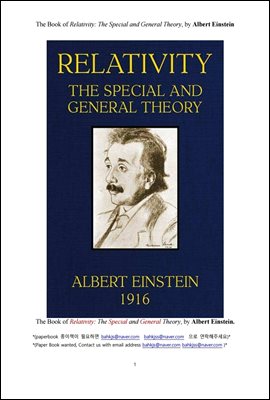
아이슈타인의 상대성이론 (The Book of Relativity: The Special and General Theory, by Albert Einstein)
- 저자A Einstein 저
- 출판사뉴가출판사
- 출판일2020-02-17
- 등록일2020-12-21
- SNS공유


- 파일포맷PDF
- 파일크기3MB
- 공급사YES24
-
지원기기
PC
PHONE
TABLET
프로그램 수동설치
전자책 프로그램 수동설치 안내
아이폰, 아이패드, 안드로이드폰, 태블릿,
보유 1, 대출 0,
예약 0, 누적대출 8, 누적예약 0
책소개
아이슈타인의 상대성이론.The Book of Relativity: The Special and General Theory, by Albert Einstein물리학의 일반 특수 상대성 이론. 2500년 전의 유클리드 기하학 개념부터 나옴.
Relativity
The Special and General Theory
A Popular Exposition
By
Albert Einstein, Ph.D.
Professor of Physics in the University of Berlin
Authorised Translation by
Robert W. Lawson, D.Sc.
University of Sheffield
1916
목차
아이슈타인의 상대성이론.The Book of Relativity: The Special and General Theory, by Albert EinsteinTABLE OF CONTENTS
Preface
I. The Special Theory of
Relativity
I. Physical
Meaning of
Geometrical
Propositions
II. The System of
Co-ordinates
III. Space and
Time in
Classical
Mechanics
IV. The Galileian
System of Co ordinates
V. The Principle
of Relativity in
the Restricted
Sense
VI. The Theorem
of the Addition
of Velocities
Employed in
Classical
Mechanics
VII. The Apparent
Incompatibility
of the Law of
Propagation of
Light with the
Principle of
Relativity
VIII. On the Idea of
Time in
Physics
IX. The Relativity
of Simultaneity
X. On the
Relativity of
the Conception
of Distance
XI. The Lorentz
Transformation
XII. The Behaviour
of Measuring Rods and
Clocks in
Motion
XIII. Theorem of the
Addition of
Velocities. The
Experiment of
Fizeau
XIV. The Heuristic
Value of the
Theory of
Relativity
XV. General
Results of the
Theory
XVI. Experience and
the Special
Theory of
Relativity
XVII. Minkowski’s
Four Dimensional
Space
II. The General Theory of
Relativity
XVIII. Special and
General
Principle of
Relativity
XIX. The
Gravitational
Field
XX. The Equality of
Inertial and
Gravitational
Mass as an
Argument for
the General
Postulate of
Relativity
XXI. In What
Respects Are
the
Foundations of
Classical
Mechanics and
of the Special
Theory of
Relativity
Unsatisfactory?
XXII. A Few
Inferences
from the
General
Principle of
Relativity
XXIII. Behaviour of
Clocks and
Measuring Rods on a
Rotating Body
of Reference
XXIV. Euclidean and
Non-Euclidean
Continuum
XXV. Gaussian Co Ordinates
XXVI. The Space Time
Continuum of
the Special
Theory of
Relativity
Considered as
a Euclidean
Continuum
XXVII. The Space Time
Continuum of
the General
Theory of
Relativity is
Not a
Euclidean
Continuum
XXVIII. Exact
Formulation of
the General
Principle of
Relativity
XXIX. The Solution of
the Problem of
Gravitation on
the Basis of the
General
Principle of
Relativity
III. Considerations on the
Universe as a Whole
XXX. Cosmological
Difficulties of
Newton’s
Theory
XXXI. The Possibility
of a “Finite”
and yet
“Unbounded”
Universe
XXXII. The Structure
of Space
According to
the General
Theory of
Relativity
I. Simple Derivation of the
Lorentz Transformation
[Supplementary to
Section XI]
II. Minkowski’s Four Dimensional Space
(“World”)
[Supplementary to
Section XVII]
III. The Experimental
Confirmation of the
General Theory of
Relativity
(a). Motion of the
Perihelion of
Mercury
(b). Deflection of
Light by a
Gravitational
Field
(c). Displacement
of Spectral
Lines Towards
the Red
IV. The Structure of Space
According to the General
Theory of Relativity
[Supplementary to
Section XXXII]

















